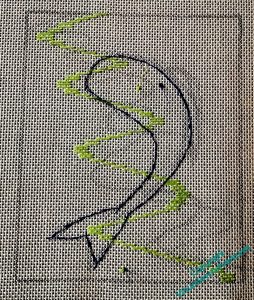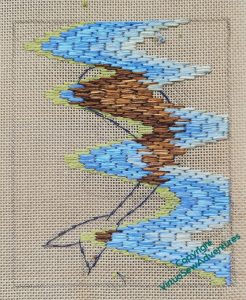A Second Fishy Experiment
So, having learnt enough to be encouraged by the First Fishy Experiment, I embarked upon my Second Fishy Experiment.
Again, I drew out the borders, tacked the edges of the fish, and drafted the line of the bargello pattern using coloured sewing cotton. You can see how many times I thought and rethought what I was going to do in pencil beforehand!
I’m using the same bit of leftover canvas, so again my threads will be blended using nine strands of stranded cotton, although I’ve added a bit to the fish by using a variegated metallic machine embroidery thread as one of the strands.
This time the experiment is to see whether I can create something of the effect of looking through the surface of water at the fish. That means making the edges of the fish uneven, rather than crisp, so rather than an entirely different set of stitch choices for the fish, and compensation stitches everywhere, I will use the same stitch pattern throughout.
That in turn means that as I approach the edge of the fish on each row, I have a decision to make about whether to use the water colour or the fish colour for the stitch that straddles the edge. Fortunately, this isn’t the sort of decision I find unnerving or difficult to make, and even here, I think you can see that this idea is rather likely to work!
I realise that the post about starting the Second Fishy Experiment somehow managed to end up well behind the videos. Episode 57 of Slow TV Stitchery is now live, in which we muse on the effects of blending colours in the needle, the demise of Scottish pearling, and the final “It depends!” moment.



“It Depends” is indeed a good answer. Fishy 2 has neatly caught the look of something moving, seen through rippling water. Get enough of the shape there (where “enough” is yet another “it depends”, of course) and the observer’s mind will do the rest. And be happier for having had to contribute.
I like this approach, and you have made the scene very realistic.
Love the water effect!
I like this approach. I may even have to try it myself!
Watching the water and the fish merge is such an interesting process!